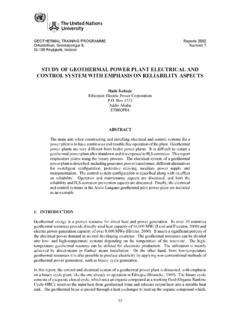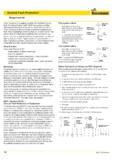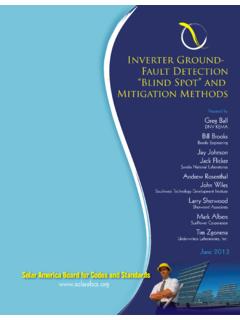Transcription of MAIN CONSIDERATIONS IN THE PROTECTION …
1 GEOTHERMAL TRAINING PROGRAMME Orkustofnun, Grensasvegur 9, Reports 2010 IS-108 Reykjavik, Iceland Number 7 29 main CONSIDERATIONS IN THE PROTECTION system DESIGN FOR A GEOTHERMAL POWER PLANT Luis A. Aguirre LaGeo de 15 Avenida Sur, Colonia Utila Santa Tecla, La Libertad EL SALVADOR ABSTRACT A proper PROTECTION system guarantees reliable and safe operation for a geothermal power plant. It is one of the most important factors during system engineering design and must be carefully selected to avoid equipment damage due to failures. The process design should include the selection of a PROTECTION scheme as well as adequate main and auxiliary equipment and installation CONSIDERATIONS .
2 An adequate process design guarantees the reliable operation of PROTECTION systems and prevents damage to main equipment if an electrical or mechanical fault occurs in a geothermal power plant. The information and data obtained are based on documents from Berlin power plant in El Salvador and Hellisheidi power plant in Iceland. 1. INTRODUCTION Geothermal energy is one of the most important forms of renewable energy in the world and has several uses. In El Salvador, the main use for geothermal energy is power generation. There are two geothermal fields in El Salvador that have operating power plants: Ahuachap n and Berlin. Their combined installed capacity is MW.
3 PROTECTION systems are one of the most important factors in geothermal power plants and ensure safe and reliable operation of the plant. PROTECTION systems can be divided into two groups, electrical PROTECTION and mechanical PROTECTION . Electrical PROTECTION functions are identified by device function numbers found on each device installed in electrical equipment (IEEE, 1996). In geothermal power plants, the electrical PROTECTION systems are almost the same as in other generation plants, such as hydroelectric or thermal generation plants, as the electrical components of the system are almost the same, with only minor differences or sizes. The main difference between geothermal power plants and other kinds of generation plants is the generation process.
4 Therefore, mechanical PROTECTION is the main speciality for geothermal power plants. Mechanical PROTECTION includes process PROTECTION , like pressure or temperature measurements, and turbine-generator PROTECTION , like vibration or eccentricity. Aguirre 30 Report 7 The most important equipment taken into account in PROTECTION systems for a geothermal power plant in the present report are: turbine, generator, unit transformer and main motors, such as circulation pump motors and cooling tower fan motors. However, the PROTECTION CONSIDERATIONS described in this report can be applied to other equipment such as auxiliary transformers or pump motors.
5 The PROTECTION system design CONSIDERATIONS involve the electrical and mechanical PROTECTION functions for the most important equipment as well as other important factors which, although they may seem small, are equally important. These CONSIDERATIONS include technical characteristics for main and auxiliary equipment selection, as well as installation CONSIDERATIONS for reliable operation. 2. main EQUIPMENT PROTECTION Generator PROTECTION description In the power plant, the generator is one of the most expensive pieces of equipment; therefore, electrical faults must be identified and cleared in due time (Estevez, 2009). Synchronous generator PROTECTION requires consideration of harmful abnormal operating conditions more than that of any other power system element.
6 A simplified functionality of a synchronous generator can be described as follows: An electromagnetic field is developed by circulating direct current through loops of wire wound around stacks of magnetic steel laminations. These are called field poles, and they are mounted on the perimeter of the rotor. The rotor is attached to the turbine shaft, and rotates at a fixed speed. When the rotor turns, it causes the field poles (the electromagnets) to rotate and move past the conductors mounted in the stator. This, in turn, causes a voltage to be induced in the generator stator windings that are connected to the output terminals (Faraday s law of induction).
7 Generator grounding It is common practice to ground all types of generators through some form of external impedance. The purpose of this grounding is to limit the thermal and mechanical stresses and fault damage in the machine, to limit transient overvoltages during faults and to provide a means for detecting ground faults within the machine (IEEE, 1995). The most common grounding method for large generators is high resistance grounding. In this method, a distribution transformer is connected between the generator neutral and ground and a resistor is connected across the secondary. For a single phase to ground fault at the machine terminals, the primary fault current will be limited to a value in the range of about 3-25 A.
8 In some cases, the distribution transformer is omitted and a resistance of high value is connected directly between the generator neutral and ground . The resistor size is selected to limit ground - fault current to the range of 3-25 A. While this method of grounding is commonly used in Europe, the physical size of the resistors, the required resistor insulation level and the cost may preclude its use. Excitation system The most common excitation system used in geothermal power plants is the alternator rectifier exciter and rotating rectifiers (brushless exciter). Figure 1 shows an excitation system that uses an alternator, but by mounting the DC field winding on the stator of the exciter and the AC armature winding on the rotor, all brushes and commutators have been eliminated.
9 In this system , the AC armature of the exciter, the rotating three-phase diode bridge rectifier, and the main field of the AC generator are all mounted on the same rotating shaft system . All electrical connections are made along or through the centre of this shaft (IEEE, 1995). Report 7 31 Aguirre Generator stator thermal PROTECTION Thermal PROTECTION for the generator stator winding (49) may be provided for generator overload. Most generators are supplied with a number of temperature sensors to monitor the stator winding temperature.
10 These sensors are usually resistance temperature detectors (RTD) or thermocouples (TC). These sensors are used to continuously monitor the stator winding. The sensors may be connected for alarm purposes. In some applications, a current measurement is combined with a timing function to establish a thermal image of the stator winding temperature. Generator stator fault PROTECTION Generator faults can cause severe and costly damage to insulation, windings and the core; they can also produce severe mechanical torsional shock to shaft and couplings. fault current can continue to flow for many seconds after the generator is tripped from the system and the field disconnected because of trapped flux within the machine, thereby increasing the amount of fault damage (IEEE, 1995).










